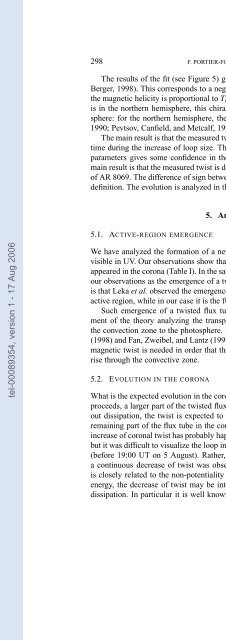Etude de la couronne solaire en 3D et de son évolution avec SOHO ...
Etude de la couronne solaire en 3D et de son évolution avec SOHO ...
Etude de la couronne solaire en 3D et de son évolution avec SOHO ...
You also want an ePaper? Increase the reach of your titles
YUMPU automatically turns print PDFs into web optimized ePapers that Google loves.
tel-00089354, version 1 - 17 Aug 2006<br />
298 F. PORTIER-FOZZANI ET AL.<br />
The results of the fit (see Figure 5) give a left-han<strong>de</strong>d helix (cf., <strong>de</strong>finitions in<br />
Berger, 1998). This corresponds to a negative twist (Tw) and a negative helicity as<br />
the magn<strong>et</strong>ic helicity is proportional to Tw 2 (Berger, 1985). As the region studied<br />
is in the northern hemisphere, this chirality agrees with the usual rules by hemisphere:<br />
for the northern hemisphere, the magn<strong>et</strong>ic helicity is negative (Seehafer,<br />
1990; Pevtsov, Canfield, and M<strong>et</strong>calf, 1995).<br />
The main result is that the measured twist (Table I) <strong>de</strong>creased continuously with<br />
time during the increase of loop size. The coher<strong>en</strong>t evolution found for the fitting<br />
param<strong>et</strong>ers gives some confi<strong>de</strong>nce in the technique <strong>de</strong>veloped in Section 3. The<br />
main result is that the measured twist is <strong>de</strong>creasing with time during the emerg<strong>en</strong>ce<br />
of AR 8069. The differ<strong>en</strong>ce of sign b<strong>et</strong>we<strong>en</strong> Tw and ψ comes from the geom<strong>et</strong>rical<br />
<strong>de</strong>finition. The evolution is analyzed in the next section.<br />
5.1. ACTIVE-REGION EMERGENCE<br />
5. Analysis<br />
We have analyzed the formation of a new active region where a s<strong>et</strong> of loops was<br />
visible in UV. Our observations show that these loops were twisted wh<strong>en</strong> they first<br />
appeared in the corona (Table I). In the same way as Leka <strong>et</strong> al. (1996), we interpr<strong>et</strong><br />
our observations as the emerg<strong>en</strong>ce of a twisted flux tube. However, one differ<strong>en</strong>ce<br />
is that Leka <strong>et</strong> al. observed the emerg<strong>en</strong>ce of 5 small bipoles in an already existing<br />
active region, while in our case it is the full active region which is emerging.<br />
Such emerg<strong>en</strong>ce of a twisted flux tube is expected from the rec<strong>en</strong>t <strong>de</strong>velopm<strong>en</strong>t<br />
of the theory analyzing the transport of magn<strong>et</strong>ic flux from the bottom of<br />
the convection zone to the photosphere. In<strong>de</strong>ed both Emon<strong>et</strong> and Mor<strong>en</strong>o-Insertis<br />
(1998) and Fan, Zweibel, and Lantz (1998) show in<strong>de</strong>p<strong>en</strong><strong>de</strong>ntly that a minimum of<br />
magn<strong>et</strong>ic twist is nee<strong>de</strong>d in or<strong>de</strong>r that the flux tube keeps its coher<strong>en</strong>ce during its<br />
rise through the convective zone.<br />
5.2. EVOLUTION IN THE CORONA<br />
What is the expected evolution in the corona of such a flux tube? As the emerg<strong>en</strong>ce<br />
proceeds, a <strong>la</strong>rger part of the twisted flux tube is pres<strong>en</strong>t in the corona, thus, without<br />
dissipation, the twist is expected to grow up to a maximum value (wh<strong>en</strong> the<br />
remaining part of the flux tube in the convective zone is no longer buoyant). This<br />
increase of coronal twist has probably happ<strong>en</strong>ed in our analyzed case earlier in time<br />
but it was difficult to visualize the loop in EUV in this early stage of the emerg<strong>en</strong>ce<br />
(before 19:00 UT on 5 August). Rather, wh<strong>en</strong> we were able to follow the loops,<br />
a continuous <strong>de</strong>crease of twist was observed (Table I). Since the magn<strong>et</strong>ic twist<br />
is closely re<strong>la</strong>ted to the non-pot<strong>en</strong>tiality of the magn<strong>et</strong>ic field and thus to its free<br />
<strong>en</strong>ergy, the <strong>de</strong>crease of twist may be interpr<strong>et</strong>ed as the consequ<strong>en</strong>ce of magn<strong>et</strong>ic<br />
dissipation. In particu<strong>la</strong>r it is well known that a pot<strong>en</strong>tial magn<strong>et</strong>ic field, with no

















